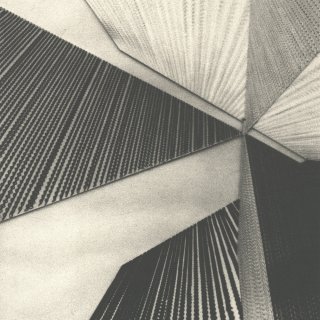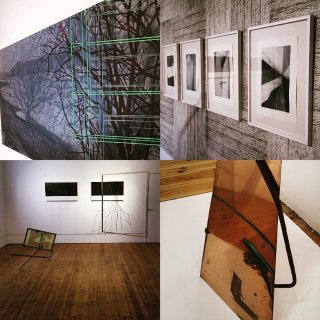Yasmin Ali
Urbanism // Design
Abstraction from Architecture
October 31st, 2015Abstraction from Architecture was an exhibition recently held at Edinburgh Printmakers. It was curated by the artist Bronwen Sleigh, known for the influence of architectural features within her work which was also featured within this exhibition. It also features the work of George Charman, Carla Scott Fullerton, and Andrew MacKenzie, all artists chosen by Sleigh for their focus on architecture.
Bronwen Sleigh's work features manmade places and forms, including architecture and a careful documentation process to translate the shapes to 2d prints and 3d drawings and sculptures. Her eye for architecture brought together these artworks and artists through careful curation.
MacKenzie's work features abstracted line drawings in bright pastelwork overlaid on traditional landscapes. Two paintings, one from Edinburgh University's collection and one from London, plus four pastel and gouache on paper drawings made bespoke for this exhibition including 2 lithographs made with EP assistant director Alastair Clark.
Sculptor Fullerton worked with Glasgow Print Studio to produce sculptures which playfully incorporated screens for screenprinting within the work, as well as moulded copper sculptures from etching and litho plates
Charman's work combines surface quality and the use of printmaker to abstract a surface, as well as understanding the role of the viewer's response to the environment. A featured piece includes a rubbing from a building from his neighbourhood estate, combined with a screenprint dusted with cement to produce a mesmerising pattern. A series of work in frames (pictured) explore the nature of interior space through collaged printed imagery of a striking installation featuring chains.
12 September - 24 October 2015
edinburghprintmakers.co.uk/exhibitions/Abstraction-from-Architecture
Abstraction from Architecture
Artists: George Charman, Carla Scott Fullerton, Andrew McKenzie and Bronwen Sleigh
BOXPARK, London: Retail starts in boxes...
October 19th, 2014
BOXPARK is dubbed as the world's 'first 'pop-up' mall', by streetwear brand BOXFRESH, founded in 1989, opened in East London three years ago. I'm visiting London so I took the time to go see it, as it has long been on my London to-do list. Its innovative concept looks like shipping containers on plan, and actually makes use of these in its construction.
Shipping containers have found popular repurposing in buildings of late, including notably Dundee's District 10, an office complex, but somehow still look fresh when seen in context. BOXPARK also has a strong digital brand and online presence, as well as plans to go cashless and pay soley via its app. While there, I visited resident streetwear and record brand MILLIONHANDS to return an online purchase, and it was all done smoothly at the touch of a computer button.
The mall has a streetscape at Ground level and an upper level foodcourt with a range of eateries including chains and one-off outlets, as well as communal picnic areas. There is also space for regular events and parties on the upper level. The retailers chosen at Ground level all have strong brands, including the independent labels, and many carry a generous 20% student discount to appeal to the youth vote Boxing clever, BOXPARK punches above its weight within its competitive locale of trendy Shoreditch.
Boxpark Website - here
// Images from BOXPARK marketing pack
Event Review: How Near is Here? Locality Programme, Collective
September 20th, 2014

'How Near is Here?' Intensive Programme / Tuesday 9 - Friday 12 September
| Collective |
| Session Review | Thursday 10am - 1pm
Last Thursday, I attended part of a intensive programme of talks, walks, workshops and discussions at Collective, centred around themes of Locality and consquent roles of public art and urban interventions within a given locale or local context. Key questions posed included:‘What constitutes the local now?’ and ‘What role does art (and culture) play in constructing a locality?’
The intensive programme and its symposium were titled 'How Near is Here?' and formed Collective Gallery's Summer School with attendees largely ECA Art graduates and professionals engaged in contemporary art practice and academia or community arts.
The workshop I attended was led by artist collective Eastern Surf, who presented an interesting series of work from their portfolio, including novel self-initiated projects such as The Meta Model, a 3D virtual model which brings together areas of work from disparate locations. It also exists as a 3D animated walkthrough and a physical architectural model. They explore similar themes in their in-situ work, Quartermile Render Ghosts. This satirical work saw the photography of people in poses similar to those in architectural visuals, walking through the housing development, posing questions as to the nature of architectural representation, public/private interfaces, and issues of surveillance and CCTV. This set the tone for the interactive workshop in which we produced paper and painted versions of rendered masks, emulating the style of facial detection and recognition software. We also explored the themes and ethos of identity camouflage which is a growing part of this dystopic vision of the future, with software currently piloted around the world, including America and New Zealand.

Above: Eastern Surf's Meta Model
Emma Balkind, PhD Candidate at Glasgow School of Art, was the respondent to this session, and presented a series of ideas around recent urban interventions, including the failed Aberdeen City Garden project, which was blocked by a private developer. Referencing sources as disparate as Hannah Arendt and Law on Common Lands, Balkind explore dialectics of Urban Vs Rural; Feudalism/Capitalism; Public/Private; The Common and The Enclosure, and The Virtual Vs The Physical. Her discussion also touched on aspects of inhabitation, land amenity and The Human Condition.
The settings provided food for thought; the gallery is part of The City Observatory on top of Calton Hill, having moved from its Old Town location over a year ago. With idyllic panoramic views of the city, as well as provocative changing exhibitions, the venue is well worth a visit.
// With Thanks to Collective
Event Review: Beyond Borders Festival 2014, 23rd/24th August 2014
August 27th, 2014

This year I attended Beyond Borders International Festival of Literature and Thought, which has been running since 2010, previously known as Borders, Books and Bikes. The programme was packed with cycle tours, guided walks, author’s talks and political debates and discussions. A central theme has always been Peace and Conflict, and contested territories were discussed in several forums. The event is held in the grounds and within Traquair House, Scotland’s oldest continually inhabited house, a picturesque stately home near Peebles.
I was lucky to sit in on a dialogue with war photographer Paul Conroy’s lunchtime talk subtitled ‘Seeking Sanctuary’ about his British Red Cross exhibition of the same name. Here Paul described his photographic portraiture project documenting Syrian refugees seeking asylum in Scotland. Conroy told of the challenges of depicting people without showing their faces, in rooms with no real distinctive features, and the daunting task of portraying character in such surroundings. In Conroy’s words, he described it as more challenging than his war photography overseas. The photographs were also on display in the Exhibition tent and are on tour throughout the UK this year.
The following day, for the first talk we sought sanctuary in the chapel at Traquair House for a discussion with Feeding Frenzy author Paul McMahon, about the politics of food in the 21st century. McMahon was joined by Delfina Foundation director and Director of Visual Arts of Beyond Borders Scotland, Aaron Cezar, who presented slides of recent artwork on food politics from the Delfina Foundation for hungry eyes. Lawyer, author and academic Oscar Guardiola-Rivera led the discussion; and also chaired The Rule of Law discussion, which is an event common to many previous Beyond Borders’ Festivals. Sir Jeffrey Jowell QC of the Bingham Centre for the Rule of Law, the UN’s Andrew Gilmour, and David Marshall were on the panel to discuss what the rule of law means for today’s international policymakers, and how to sensitively – and modestly – intervene in international relations.
I found most provocative the discussion ‘Lifting the veil’, in particular, details of journalist and Iranian correspondent Ramita Navai’s book Tehran: City of Lies, which exposes details of contemporary urban life in Iran, including double-standards and deceptive appearances within society. Navai was able to infiltrate areas of Tehran invisible to many of its citizens and tell surprising stories which have been woven into narrative fiction. Also present was author and columnist Yasmin Alibhai-Brown positing the counter question regards the danger of Muslim women in the West reassuming the veil. The discussion was chaired and led by author Bonnie Greer OBE.
Beyond Borders events continue with its film festival in Edinburgh this week, and more events planned for 2015. For details of future events go to the website here.
// With Thanks to the Beyond Borders Team based in Edinburgh
Product Review: Kala's pocket Sundial
August 22nd, 2014
This month I have a product to review that brightened my day, in the form of a pocket sundial. The role of sunlight in design is something that architects have worked with for hundreds of years. There is a pocket version of an ancient tool available to help with solar studies, via a pocket sundial that is a thing of beauty. H. M. Kala’s Sundial, also subtitled as the Sunwatch, it tells the time of day by the position of the Sun, determined by aligning its moveable calibrated concentric rings. Its type is known as the universal equinoctial ring dial, a portable version originally designed in the 15th Century for sailors.
The rings are called equatorial and meridian rings, or Gemma’s rings, and when not in use can be folded together into a small flat disk. The central bar holds a perforated slider that was positioned to the month and day according to a scale scribed on the bar. This style of sundial indicates true North and is aligned with the Earth's axis; to do this, the user configures the appropriate latitude setting to the location. This means the sundial also functions as a miniature model of the Earth and a compass.
As well as the illustrious history of its original invention, the Kala sundial has a proud family history and German engineering. It’s a remarkable instrument miniaturised to take on your travels.
Retails at 42euros+shipping // For more information see website here
With thanks to Matthaeus Kala of H.M.Kala








